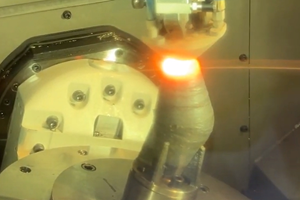Fending Off Spindle Failure
In addition to offering seminars on spindle preventative maintenance, GTI Spindle Technology also has a portable vibration analysis unit that can be operated via a tablet app.
Share





As machine tool spindles have gotten faster and more complex, the costs associated with repairing those spindles have increased. According to Tom Hoenig, president of GTI Spindle Technology, the average cost of spindle repair is now closer to $10,000 compared to $3,500 not so many years ago.
Mr. Hoenig’s company, a preventative maintenance and spindle repair specialist headquartered in Manchester, New Hampshire, commonly offers training seminars at machining facilities that address a variety of topics related to spindles. He says that 70 percent of spindle failures result from either a crash/impact between the spindle and the workpiece or fixture, or from spindle bearing contamination.
Crashes commonly occur because of human error, he explains. This includes programming mistakes, a misaligned tool, a toolholder improperly mated with the spindle, or fixturing that has been mounted incorrectly. And while crash sensors are now available on machine tools, they tend to mitigate damage rather than prevent it from happening in the first place.
Spindle bearing contamination can occur when an operator directs an air hose at the spindle while blowing away coolant from the workpiece, fixtures other components. Mr. Hoenig says this can force particulate matter in the coolant into the spindle’s bearings. (Misdirected coolant nozzles can also cause this.) Positive-pressure “purging” seals are available to protect the interior of the spindle, but they can still be defeated by the high pressure of air or coolant streams.
In addition, the design of some high-speed spindles can make it difficult to prevent contamination. Traditional rotating components employ contact seals against contamination. In order to achieve the higher speeds that spindles require, the contact between rotating components needs to be minimized, thus excluding contact seals from use and requiring what is known as “labyrinth seals,” which can permit contamination.
Beyond crashes and spindle bearing contamination, Mr. Hoenig says the remaining 30 percent of spindle failure is caused by lack of proper spindle lubrication, failure of spindle support equipment such as chillers, and failed connections within the machine tool’s electrical system.
So how can a shop go about protecting its increasingly hefty investment in machine tool spindles? Here are a few topics that GTI addresses in a typical spindle preventative maintenance seminar:
-
Preventing contamination of machining fluids.
-
Proper spindle installation and removal.
-
Bearing impact prevention.
-
Best tooling interface approaches.
Mr. Hoenig also suggests that shops consider investing in a portable vibration analysis unit that can be operated via a tablet app. The app works with an accelerometer, which is a piezoelectric measurement device used to measure specific vibration at particular frequencies. GTI’s accelerometers are now wireless and have a magnetic base for easy mounting to the spindle.
As for the frequency of testing, Mr. Hoenig recommends using it monthly, or particularly after a spindle crash/impact, in order to determine the exact spindle condition. Conducting this exercise on a monthly basis enables the user to watch the deterioration of the spindle over time. Conversely, outside service companies can be contracted to conduct periodic testing using one of these units. Some service providers, including GTI, also can attach a permanent-mount sensor to the spindle that uploads data to the cloud, where the company can monitor it and alert the shop when data show that a spindle problem may be imminent.
Related Content
Orthopedic Event Discusses Manufacturing Strategies
At the seminar, representatives from multiple companies discussed strategies for making orthopedic devices accurately and efficiently.
Read More6 Machine Shop Essentials to Stay Competitive
If you want to streamline production and be competitive in the industry, you will need far more than a standard three-axis CNC mill or two-axis CNC lathe and a few measuring tools.
Read More4 Commonly Misapplied CNC Features
Misapplication of these important CNC features will result in wasted time, wasted or duplicated effort and/or wasted material.
Read MoreAdditive/Subtractive Hybrid CNC Machine Tools Continue to Make Gains (Includes Video)
The hybrid machine tool is an idea that continues to advance. Two important developments of recent years expand the possibilities for this platform.
Read MoreRead Next
AMRs Are Moving Into Manufacturing: 4 Considerations for Implementation
AMRs can provide a flexible, easy-to-use automation platform so long as manufacturers choose a suitable task and prepare their facilities.
Read MoreMachine Shop MBA
Making Chips and 91ÊÓƵÍøÕ¾ÎÛ are teaming up for a new podcast series called Machine Shop MBA—designed to help manufacturers measure their success against the industry’s best. Through the lens of the Top Shops benchmarking program, the series explores the KPIs that set high-performing shops apart, from machine utilization and first-pass yield to employee engagement and revenue per employee.
Read More





















